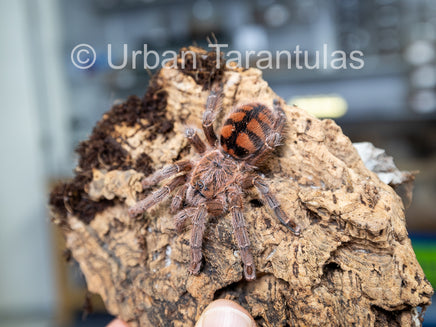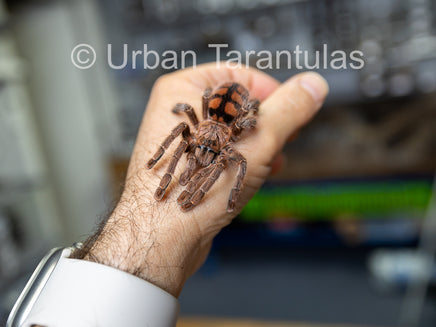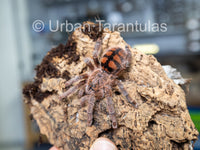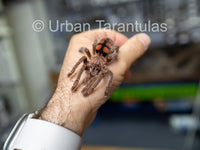Avicularia minatrix
Meet the Avicularia minatrix, a true gem among tarantulas with its striking orange-brown color and compact form. Known for its gentle nature and manageable size, this beauty is perfect for those seeking a unique arboreal species that’s as captivating as it is easy to care for. Its distinct markings and calm demeanor make it a favorite among collectors and enthusiasts alike.
Care Details
-
Temperature: Keep your Avicularia minatrix between 75 to 85°F (24 to 29°C). Warmer environments encourage faster growth, increased feeding, and quicker molts, making this species a flexible and low-maintenance addition.
-
Humidity: Maintain humidity at 70–80%. Water dishes are not necessary, but if used, they pose no harm. I personally do not use them.
-
Housing:
- Arboreal species: For babies, a small vial up to 5 inches tall and 2 inches in diameter with ventilation. Free vials available at checkout—please request during checkout if you’d like one; otherwise, it won’t be included.
- For juveniles larger than 2 inches, an enclosure 7-8 inches tall is ideal. Adults thrive in enclosures between 12 and 16 inches tall.
-
Diet: I personally give them a variety of crickets and cockroaches, including Dubia, Red-runner, Lobster, and Madagascar hissing roaches. For the baby tarantulas, baby crickets and baby roaches are ideal. If you have access to only one type of prey, that is also perfectly fine.
If you cannot find a small enough cricket or cockroach, just crush its head and leave it in the enclosure; your tarantula should handle the rest.
Remember to remove any uneaten food to prevent any mold growth.
And for an occasional treat, a pinky or hopper mouse adds a nice variety to their diet. Make sure to not overfeed rodents and feeder lizards to your tarantulas, these should be done every once in a while as a treat. Too much calcium is not good for the tarantula as it can cause constipation, and the tarantula might have a hard time pooping.
In-depth Facts
- Latin name: Avicularia minatrix
- Common name: Venezuelan Red Slate Pinktoe, Venezuelan Red-stripe
- Locale: Venezuela, typically found in moist forest areas.
- Category: Arboreal; light webbing with a tendency to explore rather than heavily web or burrow.
- Size: Females grow to around 4 inches, males slightly smaller.
- Urticating hairs: Don't have to worry about hairs with this species
- Growth rate: Moderate to fast
- Life span: Females live up to 15 years, while males generally live up to 3-4 years.
- Recommended level: Suitable for enthusiasts looking for a hardy, vibrant arboreal tarantula.
Stay Connected:
- Instagram: Follow my Instagram, I'm most active here.
- YouTube: For care and education videos, check out my YouTube channel.
- Facebook: Over here I have all my reviews.
- TikTok: Visit my TikTok for additional content.
Safety Disclaimer:
Experiencing a tarantula bite is an extremely rare occurrence, and it's important to note that there have been no recorded fatalities due to a tarantula bite. The venom potency varies across species, with Old World tarantulas generally having stronger venom than their New World counterparts. Within the Old World category, the Poecilotheria genus is known for having particularly potent venom.
It's crucial to approach tarantulas with respect and understanding. If you happen to get bitten, which is unlikely, the key is to stay calm. In most cases, the discomfort is superficial and subsides within a few minutes to a few hours. However, bites from species with more potent venom may result in symptoms lasting up to a week. Remember, larger tarantulas tend to have more venom than smaller ones.
Please be aware that I cannot assume responsibility for bites. Tarantula handling should be done at your own risk. In my 11 years of experience with these creatures, I have only been bitten once, by a species with highly potent venom. While the experience was painful, the symptoms had completely disappeared after a week.
Handle tarantulas responsibly, and always prioritize your safety and the well-being of the tarantula.



